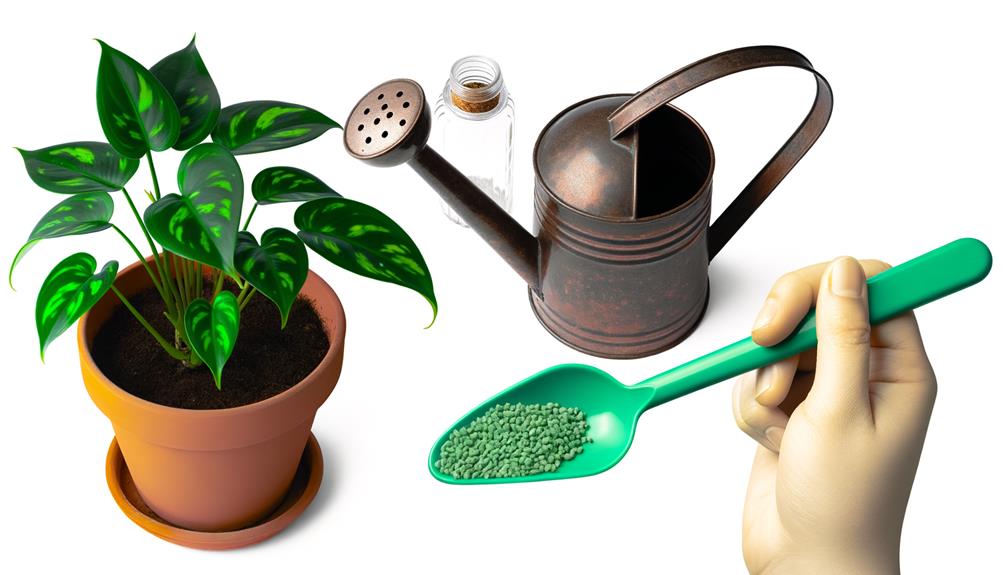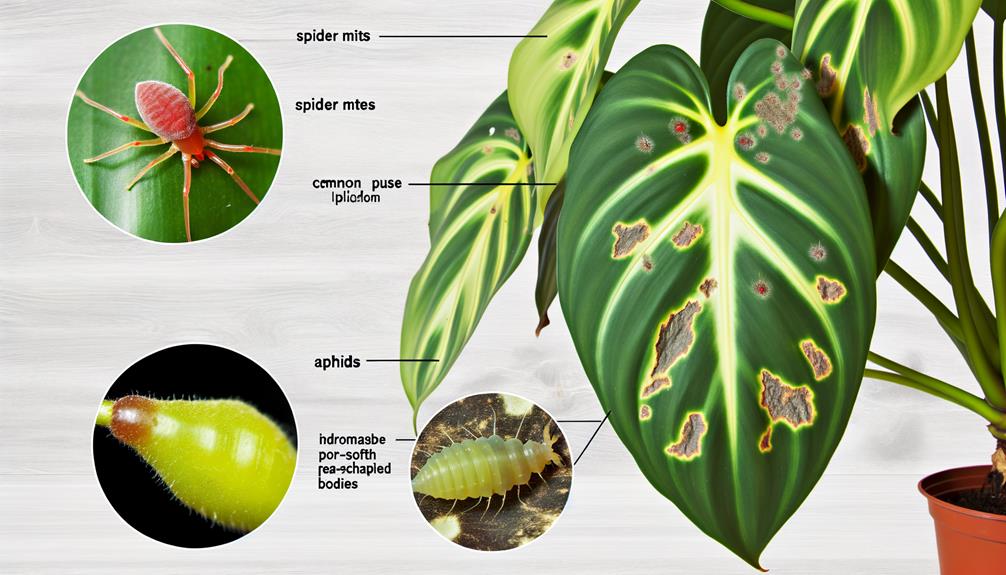Swiss Cheese Philodendron Care: Comprehensive Guide!
Swiss Cheese Philodendron or Monstera adansonii, originating from Central and South America, finds best growth under bright, indirect sunlight, replicating rainforest canopy conditions. Maintain a 12-hour light period, while avoiding direct rays to prevent leaf burn.
The plant thrives in well-draining soil, kept moist by watering when the topsoil feels dry and prefers filtered or rainwater. Regularly feed it well-balanced fertilizer, except when leaves yellow, signaling over-fertilization.
Pruning should be performed in spring or early summer, removing unhealthy leaves. Keep vigilant for pests and diseases.
Improving these conditions guarantees healthy Swiss Cheese Philodendron growth. Our detailed guide offers further cultivation strategies.

Key Takeaways
- Swiss Cheese Philodendron thrives in bright, indirect sunlight, mimicking tropical rainforest canopy conditions.
- Water the plant when the top inch of soil is dry, using filtered or rainwater to avoid harmful chemicals.
- Use a balanced houseplant fertilizer every 2-4 weeks during the growing season to promote growth.
- Prune dead or discolored leaves in spring or early summer and repot every 2-3 years in a larger container with well-draining soil.
- Regularly inspect for pests like spider mites and mealybugs, using insecticidal soap or neem oil for treatment, and remove leaves affected by fungal diseases.
Understanding Swiss Cheese Philodendron

The Swiss Cheese Philodendron, scientifically known as Monstera adansonii, is a unique tropical plant characterized by its distinctively perforated, heart-shaped leaves, which have earned it its colloquial name.
This evergreen perennial originated in Central and South America and is part of the Araceae family. While its aesthetic appeal is undeniable, it’s the plant’s adaptability that makes it a favorite among horticulturists and plant enthusiasts.
It thrives in humid conditions, with a preference for well-draining soil. The Swiss Cheese Philodendron exhibits epiphytic tendencies, often growing on other trees in their natural habitat.
Understanding these key aspects of the plant’s biology and natural environment is essential to providing proper care and helping it flourish in a domestic setting.
Ideal Lighting Conditions
Drawing from its natural habitat, the Swiss Cheese Philodendron demonstrates a preference for bright, indirect sunlight, which emulates the dappled light conditions of a tropical rainforest canopy.
To mimic these conditions, place the plant near a window that receives ample sunlight, but shielded from direct rays which can cause leaf burn. Conversely, insufficient light may cause slowed growth and smaller leaf size.
In the case of artificial lighting, fluorescent lights are recommended to provide the full spectrum of light required. East and North facing windows are ideal locations. For maximum plant health, aim for approximately 12 hours of light daily.
Watering and Fertilizing Requirements

Proper hydration and nutrition are crucial for maintaining the lively growth and robust health of the Swiss Cheese Philodendron. This plant requires careful watering and fertilizing practices to thrive.
Here are some key points to bear in mind:
- Water the plant when the top inch of soil is dry to touch. Overwatering can lead to root rot.
- Use a well-balanced houseplant fertilizer. Feed your plant every 2-4 weeks during the growing season, less frequently in winter.
- If you notice yellowing leaves, it may indicate over-fertilization. Always follow the fertilizer package directions.
- Use filtered or rainwater when possible. Chlorine and other chemicals in tap water can be harmful.
- Monitor the humidity levels around your plant. They prefer humid environments, but do not require misting.
Pruning and Repotting Guidelines
Understanding the correct methods for pruning and repotting is essential to the successful cultivation of the Swiss Cheese Philodendron, as these processes can significantly impact the plant’s growth patterns and overall health.
Pruning is best done in the spring or early summer, when the plant is in an active growth phase. Use sanitized pruning shears to trim off any dead, yellow, or brown leaves at the base of the stem.
Repotting should take place every 2-3 years in a pot that is 2 inches larger in diameter than the previous one. Utilize a well-draining soil mix, rich in organic matter.
Diligent attention to these guidelines will secure the plant thrives, offering a lush, vibrant addition to your environment.
Dealing With Common Pests and Diseases

In the world of Swiss Cheese Philodendron care, warding off common pests and diseases plays a crucial role in maintaining the plant’s overall health and vibrancy. This involves regular checks for visible signs of infestation and disease, applying appropriate treatments as needed.
To effectively manage pests and diseases, consider the following actions:
- Regularly inspect leaves for signs of pests such as spider mites, mealybugs, and scale insects.
- Look for signs of fungal diseases, including yellowing leaves or brown, wet spots.
- Use a mild insecticidal soap or neem oil to treat infestations.
- For fungal diseases, remove affected leaves and use a suitable fungicide.
- Maintain ideal growing conditions to prevent stress-related susceptibility to pests and diseases.
Philodendron Adansonii Care
- Light: Place in bright, indirect light. It can tolerate lower light but will grow more leggy.
- Water: Keep the soil slightly moist. Water when the top inch of soil is dry, about once a week. Ensure the pot has drainage holes.
- Temperature: Ideal range is 18-27°C (65-80°F). Avoid cold drafts.
- Humidity: Prefers high humidity (above 60%). Mist regularly or use a humidifier.
- Soil: Use well-draining, peat-based potting soil.
- Fertilizer: Feed every 2 weeks during the growing season with a balanced, diluted fertilizer.
- Pruning: Prune to control size and remove dead or damaged leaves. Prune in spring to autumn.
- Repotting: Repot every 1-2 years or when root-bound. Refresh soil annually.
Conclusion
To sum up, the Swiss Cheese Philodendron, with its unique fenestrated leaves, needs specific care routines to flourish. Lighting, watering, fertilization, and pruning are essential factors.
Regular checks for pests and diseases, followed by proper treatment, guarantee plant health. A well-cared-for Swiss Cheese Philodendron enhances visual appeal and enhances air quality, making the work rewarding.
Additional exploration into its distinct characteristics could unveil even more intriguing aspects of this beloved houseplant.






